Celestia Update Details: Key Features and Enhancements
In this article, we’ll break down each new feature, explain the related Celestia Improvement Proposals (CIPS), and explain why they’re important.
 JinseFinance
JinseFinance
Author: ArkStream Capital
1. The development of application chains is the result of the combined effect of many factors, including the maturity of infrastructure, intensified competition in block space, and the increasing demand for customized token economic models.
2. Although dApps and application chains have similarities in business forms, they each have their own advantages and limitations. If emphasizing synergy with the ecosystem, dApps may be more suitable, while if pursuing autonomy and independence, application chains are a better choice.
3. The development of Cosmos and Polkadot is limited, both due to technical challenges, but more due to the design of economic mechanisms and the high threshold of application chains.
4. The core of the development of application chains lies in building their own application barriers, making full use of low-cost transactions to promote high-frequency on-chain transactions, and then obtaining traffic and accumulating users. Although technical support and enhancement are important, they are only auxiliary factors, not core elements.
5. Future application chains can solve the existing liquidity fragmentation and interoperability problems through technologies such as aggregation layers, super chains or chain abstraction.
6. Although the market value or fully diluted valuation of application chains has received a certain bonus, the real key is the product quality and user experience of the application itself.
In 2023 and 2024, more and more dApps announced their transformation into application chains. In response to this phenomenon, we counted the entire application chain track and found that these application chains are mainly concentrated in DeFi, games, social networking and AI. We believe that the development of application chains has become an inevitable trend, which is due to the maturity of modular technology, the extensive verification of the general Rollup second-layer network, the increase in RaaS platforms and the improvement of services, as well as the competition for public chain block space resources by dApps, the optimization of end-user transaction costs and the promotion of token economic customization needs.
For this trend, we believe that the upgrade of dApps to application chains will not immediately transform into a highly valued infrastructure layer, because dApps and application chains are more of a technology selection rather than a decisive factor for success. The advantage of application chains is that they promote more high-frequency on-chain transactions through low-cost transactions, use data accumulation to improve user product experience, form user stickiness, and thus achieve network effects. Therefore, the core of the development of application chains still lies in their unique application barriers and traffic.

Speaking of the origin of application chains, we must mention a pioneering project, Cosmos. Cosmos is famous for its modular and pluggable design concept, which separates the virtual machine and the consensus engine, allowing developers to freely choose the framework for building virtual machines and customize the key parameters of the consensus engine, such as the number of validators and TPS. This design enables various applications to exist in the form of independent chains and show unique advantages in flexibility and sovereignty. These innovative ideas have enabled Cosmos to make important contributions to the exploration and practice of application chains, laying a solid foundation for this field.
Looking through the development of the Cosmos application chain ecosystem on Mintscan, we found that many well-known and mature application chains are built on the Cosmos framework, such as dYdX, Osmosis, Fetch AI, Band, and Stride. However, the growth trend of the overall Cosmos application chain has not continued, and the number of new application chains has not increased significantly. We believe that this is mainly because Cosmos has given the application chain too much sovereignty, and before the launch of Atom 2.0's ICS solution, the security of the application chain and the high startup and maintenance costs were the main reasons.

Usually, building a Cosmos application chain requires the project party to be equipped with a development team familiar with the Cosmos SDK and the Tendermint consensus engine, which is an additional technical burden for the technical team that focuses on application development. In addition, even if the Cosmos application chain can be equipped with enough technical personnel, the startup logic of most application chains is to attract initial validators to participate and ensure network security by airdropping tokens to Cosmos validators, while incentivizing validators to continue to maintain network security through high inflation rates. However, the side effect of this approach is that it accelerates the depreciation of tokens, causing the value of the network to fall rapidly. This situation makes it more difficult for application chains to gain a foothold in the market.
Under the ICS scheme advocated by Atom 2.0, the concept of application chains will be upgraded to the Permissionless Consumer Chains model, although it allows permissionless joining of consumer chains, reducing the cost of consumer chains to obtain security. However, this form of voting governance based on DAO is similar to the Polkadot slot auction mechanism launched at the same time, and may face the problem of inefficient development similar to the slot auction mechanism.
In addition, we found that Cosmos is not attractive enough to application chains in terms of the chain's Liveness characteristics, developer documentation resources, and community culture. For example, the block suspension incident of Cosmos Hub this year, the incomplete development documentation resources during the period of the popularity of inscriptions at the end of 2023, and the small circle problem of Interchain Foundation pointed out by Delphi co-founder José Maria Macedo, all had a negative impact on the joining of new application chains.
If we regard the early application chains of Cosmos as chain-oriented applications, emphasizing the sovereign design of the chain, then the new application chains are more application-oriented, focusing on their own application development. The rise of this new application chain is mainly due to the popularization of the concept of modular blockchain, the maturity and extensive verification of the general Rollup Layer2, the development of interoperability and liquidity aggregation layers, and the rise and improvement of RaaS platforms.
As the first Rollup Layer 2 to go online on the mainnet, Optimism's successful launch in 2022 marks the actual implementation of the modular blockchain theory. Optimism not only inherits the security of Ethereum, but also fully supports the development technology stack of the Ethereum ecosystem. Optimism shows the industry how Rollup can efficiently expand Ethereum, and at the same time, it also promotes the industry's in-depth exploration of Layer 2 solutions. On the basis of its own development, Optimism borrowed the ideas and framework of Cosmos and innovatively proposed the concept of OP Stack. This concept has been widely used in well-known projects such as Worldcoin and Base, which has further attracted widespread attention in the industry. Subsequently, other Rollup solutions have also launched similar concepts, such as Arbitrum Orbits, Polygon CDK, StarkWare Appchain and zkSync Hyperchains. In this way, for dApps, the application chain has become a new way to implement business logic. The upgrade and implementation of the original dApps is no longer a problem. The main challenge has turned to technology selection, business design and operation and maintenance.
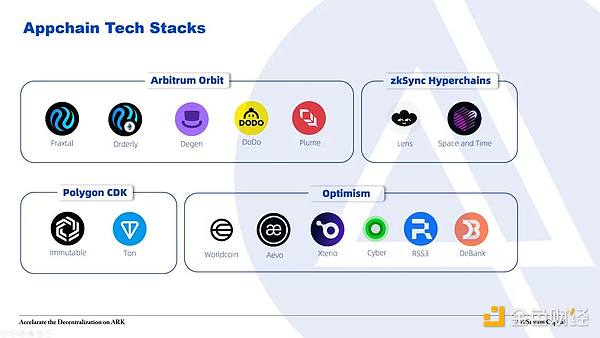
When implementing a Rollup solution, it is usually necessary to choose a suitable execution layer framework, such as OP Stack or Arbitrum Orbits. Take OP Stack as an example. It is an evolving Rollup framework that must be upgraded with Ethereum updates (such as Cancun's Blob feature) and will also support emerging features (such as Alternative Data Availability). For ease of understanding, we simplify the development process of the application chain and roughly follow the following steps:
1. Technology selection: Evaluate the functions and characteristics of different frameworks and select the most suitable framework.
2. Demand design: Design an application chain that meets the requirements based on the customization capabilities of the corresponding framework.
3. Operation and maintenance: Complete deployment, testing, launch and subsequent maintenance.
Although the Rollup framework provides powerful expansion capabilities for applications, it is not easy to choose and implement the right framework, especially after the application chain is launched, it will be more complicated to make changes. Therefore, the emergence of RaaS (Rollup As A Service) platforms such as Altlayer, Caldera and Conduit is particularly important. These platforms are similar to SaaS, but focus on Rollup solutions, which can help dApps quickly choose different Rollup frameworks, simplify the complex steps in the application chain development process, provide customized core features, and support maintenance and optimization of applications after they are launched.
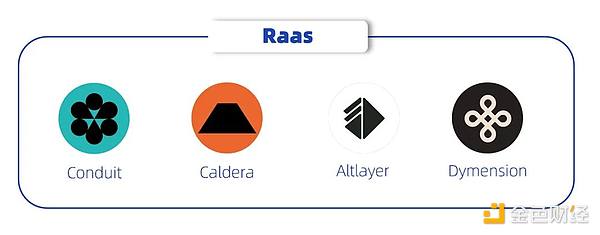
At the same time, the infrastructure and related functions around application chains are also advancing rapidly, and the industry continues to launch attractive protocols and functions. For example, projects such as Celestia, EigenDA and NearDA have introduced Alternative Data Availability to reduce costs and increase throughput, and RaaS platforms have successively launched integrated support for functions such as custom Gas tokens and native account abstraction. With the widespread application of Rollup application chains, liquidity fragmentation and interoperability problems have gradually emerged, prompting aggregation and unification layer solutions, such as Optimism's Superchain, Polygon's AggLayer, Caldera's Metalayer and zkSync's Elastic Chain, which aim to improve interoperability and liquidity aggregation between application chains.
If the above catalysts have lowered the entry threshold for application chains, then the current application dilemma in the primary and secondary markets is exacerbating dApps' exploration of a way out. From the data of CMC and Rootdata, we can see that among the top 100 projects in the secondary market, except for the community-driven and culturally supported Meme category, there are only a few pure application projects such as Uniswap, LDO, Aave, Ondo, Jupiter, Ethena, and most of the others belong to infrastructure. This invisibly confirms that infrastructure has a higher status than applications in the entire Crypto industry. Corresponding to the primary market, the amount of financing for applications is also far lower than that for infrastructure. We believe that this phenomenon is partly due to the relatively complex UI/UX of Web3 applications, which are far less mature and easy to use than Web2. At the same time, there is no real breakthrough in the innovation of related application paradigms. Despite this, we believe that the potential of application chains has not yet been fully released, and it may become an important breakthrough in promoting the development of Web3 in the future. At present, there are some well-known application chain projects, such as IMX, Cyberconnect, Project Galaxy, Worldcoin, etc., which are showing the great potential of application chains.
In the field of technology and innovation, "silver bullet" is often used to describe a perfect solution that can solve all problems. However, in reality, there is almost no technology that can solve all problems at once. Similarly, new application chains are not a universal and flawless solution. Below, we analyze its advantages and disadvantages:
Modular design: Application chains usually adopt modular design, allowing developers to customize infrastructure components such as settlement mechanisms and data availability to meet specific needs.
Optimized performance: Many new application chains can reduce costs and improve throughput by introducing other data availability layer solutions.
Enhanced value capture: Such as custom Gas tokens, account abstraction, etc., these features can support more flexible application development and make more complex business models and token models.
Liquidity fragmentation: New application chains may face the problem of liquidity fragmentation.
Interoperability and composability issues: Application chains can no longer be combined and interoperated as easily as dApps on public chains in the past.
Increased complexity: Compared with traditional dApps, new application chains are more complex, especially in design and implementation, and may require more technical resources and support.
From the perspective of the project party, when deciding whether to upgrade or select an application chain, it is recommended to follow the following principles:
1. Dependence on the characteristics of the existing public chain: If your application is highly dependent on other dApps on the public chain, such as liquidity or product functions, it is recommended to continue using the existing dApps solution.
2. Need for custom functions: If the current application is difficult to support business requirements such as account abstraction, specific onboarding mechanism (Revenue sharing) at the protocol level, and these functions are essential for business development, then it is recommended to choose or migrate to the application chain.
3. Cost sensitivity: If the end user is sensitive to block space resources, or wants to reduce losses such as MEV, the application chain may be a better choice. In addition, if the application belongs to a high-frequency interaction scenario. The application chain can provide higher resource efficiency and lower transaction costs.
We believe that the moat of the application chain will always be its own application business. The key to success lies in digging deep into the market pain points and building PMF (Product Market Fit) product applications. Simply relying on the chain infrastructure narrative of the application chain is a kind of fixed thinking of looking for nails with a hammer, and it is not an effective way to build a moat.
In the current wave of new application chains, how to build open and transparent low-cost applications on the chain, grasp market demand and solve product pain points, polish out perfect and safe products, and establish a huge and rich user data accumulation and analysis, and match a business model with a cash flow model to form a strong user stickiness and scale effect, is the key.
The high-profile route is not necessarily suitable for the application chain. At least before the core product is not perfect, user data and user growth data are not fully established, the application chain should focus on development and supplement it with publicity. The accumulation of user data, the cultivation of user habits, and the iterative update of product functions are not achieved overnight, so a steady and steady development approach is more suitable. The application should first form its own core functions as soon as possible, even irreplaceable functions. Based on this, new functions and product lines are developed. In this way, even if new functions and new product lines are met with a cold response, a defensive abandonment strategy can be adopted. Correspondingly, in terms of the upgrade and iteration of the application chain, it can also be deeply integrated with the original application functions many times.
Take the well-known portfolio visualization asset management platform Debank as an example. It has long established the tracking and observation of ETH and EVM wallet address assets, transaction flow, dApps and other positions, and iterated many functions accordingly. Although Debank has many relatively unknown functions, such as notifications, bookmarks and greetings, this does not affect our love for its core asset management functions. For Debank's paid functions, we can see their dedication in this regard. The diversified and fine-grained payment features and the integrated and optimized Package functions provide users with considerate choices. The overall data of these functions performed well and formed a good synergy with Debank's other product line Rabby Wallet. Even though Debank advertised that it had developed Debank Chain based on OP Stack, users did not have a clear perception. This shows that Debank's application chain has well demonstrated how to build a core moat for applications and provided valuable reference for the development route selection of other application chains.
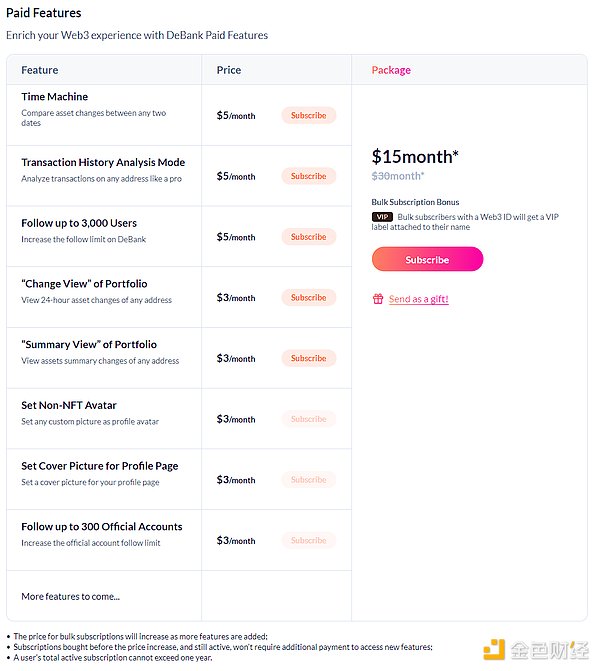

When building the token economic model of the application chain, we advocate a natural development (Organic) strategy. The core of this strategy is to reduce human intervention and avoid relying on short-term incentives. Our hope is to coordinate the circulation and value growth of tokens with the expansion of the application itself and the increase in the user base. In this way, the token economy can be synchronized with the long-term development of the application and the actual needs of users, thereby achieving sustainable growth.
Tokens can be a powerful tool to attract users in the early stages of an application and achieve the so-called "cold start". However, in order to ensure that these early users are not only attracted but also converted into long-term users, the key lies in designing an efficient and attractive mechanism. This mechanism needs to be based on a clear positioning of the application product, deep insight into user needs and preferences, and a comprehensive understanding of the business scenario. In addition, the core value of the token must also be established to ensure that users recognize its long-term potential and benefits. Through such a strategy, tokens can not only attract users, but also promote their continued participation and in-depth use of the product.
The growth of the number of token holders should be consistent with the expansion of the user base to ensure the healthy development of the token economy. We should avoid adopting an overly aggressive token distribution strategy and instead strive to achieve a model of sustained growth. This requires not only that we fully consider the current market liquidity and potential market changes, but also to ensure that the token economic model is closely linked to the vision of the application. In addition, as a new type of reservoir-type asset, NFT, innovation and appropriate combination can provide users with a variety of usage scenarios, which also helps to enhance the attractiveness and market competitiveness of tokens.
Learning from failed cases is the key to avoiding mistakes when designing tokens for application chains. Take Aevo as an example. As a new coin listed on Binance Exchange in the past six months, it will not be affected by insufficient liquidity. After attracting a large number of early users through the token airdrop expectation, Aevo has established a firm foothold in the pre-market trading market. Unfortunately, Aevo's overly aggressive and unrestrained token design model ultimately harmed the core data growth of the product. At present, Aevo has shown stagnation in key indicators such as token holder growth, daily trading activity, and the basic market of pre-market trading of the product. For this reason, in order to build a token economic model that is both attractive to users and sustainable in the long term, we advocate the idea of organic development, the core of which is to drive the natural growth of tokens and the expansion of applications with intrinsic value and user demand.
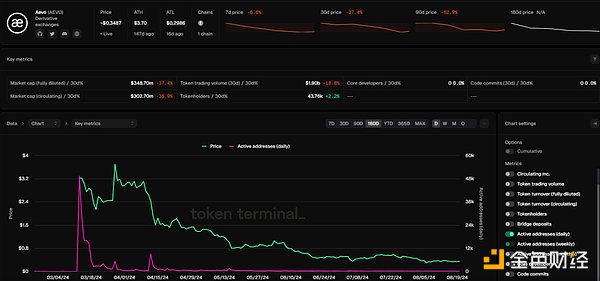
Let's take a deep look at some of the most popular application chain projects in the current market and analyze them.
Cyber
Cyber is a Restaked Ethereum second-layer network focusing on social scenarios, optimized for Mas Adoption. Core features include native account abstraction, Enshrined Social Graph Protocol supported by CyberGraph and CyberAccount, low-cost and efficient decentralized storage CyberDB, and decentralized sequencers. The core application product is Link3, which allows verified Web3 companies and professionals to create reusable data on the chain, and this data can be used in combination by other applications.
XAI
XAI is an EVM-compatible game three-layer network developed by Offchain Labs. Using Arbitrum technology, XAI allows players to own and trade their in-game items without using cryptocurrency wallets. At the same time, the node operators of the XAI network participate in network governance and receive corresponding rewards, thereby building a game ecosystem with an open and real economic experience for traditional game players.
MyShell
MyShell AI is an innovative AI Agent creator platform and a Consumer AI Layer that links users, creators, and open source AI researchers. Users can use MyShell's exclusive integrated text-to-speech technology and AutoPrompt tool to quickly customize Agents with personalized voice styles and functions. For Agent creators, they can efficiently create and publish AI Agents, and integrate monetization channels to obtain the corresponding Agent revenue. GM Network is committed to becoming an innovator in the field of consumer AIoT. It uses advanced AltLayer technology and combines EigenDA with OP Stack to create a decentralized DePIN, which aims to customize personalized AI agents for users. GM Network's goal is to build a huge incentive and communication platform, and by integrating DePIN/IoT technology with AI, promote the widespread application of AI technology on the consumer side, thereby building a bridge between the virtual world and the real world.
Some other projects
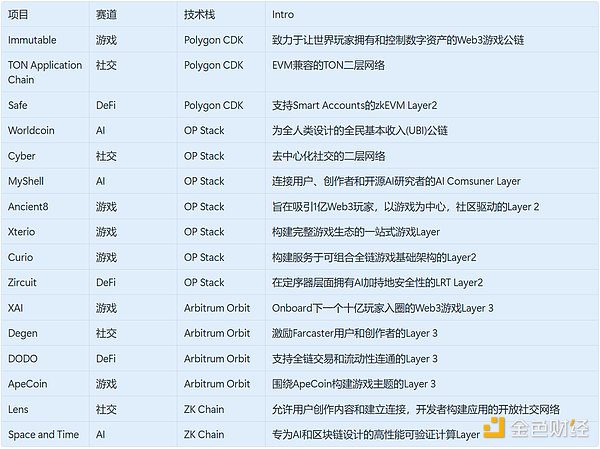
When conducting investment analysis, we use the following framework to ensure that the evaluation of the application is comprehensive and in-depth:
Industry understanding and market positioning: In-depth understanding of the gameplay and operation mode of the currency circle, know how to choose market pain points and propose novel application solutions.
Target customer group: The application is aimed at a large and potential user base, because it directly affects the ceiling of its market value.
Product delivery and iteration speed: Compared with infrastructure, applications need to have strong product delivery capabilities and fast iteration speed to ensure continuous optimization and innovation of product functions.
User retention and business model: Applications must be able to build strong user retention capabilities and achieve sustainable growth through GMV growth and matching business models.
Through this framework, we can systematically evaluate the comprehensive strength and market prospects of the project and provide a solid basis for investment decisions.
We are optimistic about the development prospects of application chains. This optimism is based on the fact that application chains are the core platform for carrying user activities, and they can play a vital role in diversified fields such as social networking and games. In the future, these application chains will not only provide users with a rich interactive experience, but also promote the innovation and development of related industries through their unique technical advantages!
1. The application business forms of To B and To C have their own characteristics, but their ideas of combining with application chains are similar. This article will not strictly distinguish between the two, but focus on how they use application chain technology to achieve business goals and growth.
2. The main difference between Layer3 and Layer2 application chains is that Layer3 uses a specific Layer2 as the settlement layer and data availability layer, that is, the structure is not much different from Layer2.
3. Solana officials have not made a clear statement to support the development of Layer2. Its focus is still on building around Solana's high-performance public chain. For some Layer2 or application chains on Solana, the ideas are similar to those of the Ethereum series of application chains, except for the execution framework and data availability layer.
4. The current situation of Layer2 seems to be a ghost town. The actual reason is that some Layer2s are too dependent on the on-chain prosperity created by the expectation of token airdrops, and have not fully operated and maintained the ecosystem. Through Defillama's https://defillama.com/chains, Layer2 data such as Arbitrum and Base are also very active.
5. There are generally multiple modes for revenue sharing between application chains and RaaS, such as fixed payment, distribution based on sequencer income, etc. For application chains of different sizes, you can choose according to your own business situation.
In this article, we’ll break down each new feature, explain the related Celestia Improvement Proposals (CIPS), and explain why they’re important.
 JinseFinance
JinseFinanceIn the future, EVM and SVM virtual machine standards will be comparable in terms of developer mindshare, number of users, and total value. In this evolution, the most noteworthy SVM L2 is Eclipse.
 JinseFinance
JinseFinanceExplore the architecture and data verification of Tagion, Filecoin, and Celestia
 JinseFinance
JinseFinanceIn the future, Celestia will be able to enjoy the incremental market gains brought by the dual trend of modularization + application chain, while EigenDA will gain more access to the Ethereum-based stock market that has higher security requirements.
 JinseFinance
JinseFinanceWill the future lead to more market competition in the direction of composable modules, leading to a new round of expansion in Ethereum’s capacity expansion?
 JinseFinance
JinseFinanceCelestia is a Data Availability (DA) blockchain designed to serve as a cost-effective and efficient hub for L2 Rollup to publish transaction data.
 JinseFinance
JinseFinanceDespite the controversy over the definition of Layer 2, the Ethereum upgrade is still focused on Rollup, of which DA is the key.
 JinseFinance
JinseFinanceCelestia (TIA) emerges as a force to be reckoned with, showcasing a remarkable 10-fold surge post-airdrop and solidifying its position as a pivotal player in the blockchain innovation and decentralized ecosystem narrative. However, potential investors are reminded to exercise caution in the volatile altcoin market.
 Sanya
SanyaSince its launch, Celestia's specially built data availability layer has been increasingly selected and applied by public chains. This article will sort out the current ecological development status of Celestia.
 JinseFinance
JinseFinanceCelestia Ecosystem emerges as a key player in blockchain innovation, offering diverse ÐApps and potential airdrops
 Alex
Alex